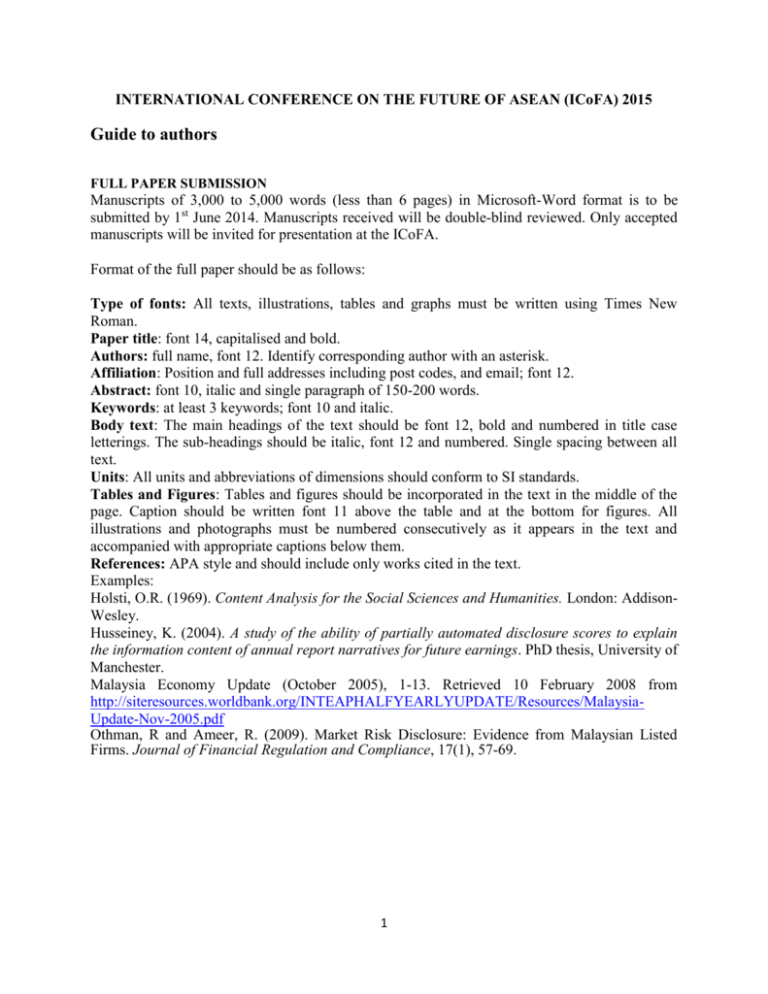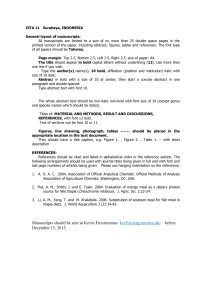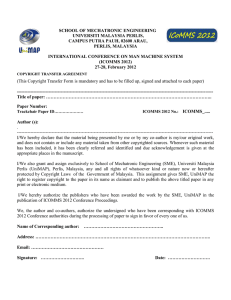for full paper formats.
advertisement

INTERNATIONAL CONFERENCE ON THE FUTURE OF ASEAN (ICoFA) 2015 Guide to authors FULL PAPER SUBMISSION Manuscripts of 3,000 to 5,000 words (less than 6 pages) in Microsoft-Word format is to be submitted by 1st June 2014. Manuscripts received will be double-blind reviewed. Only accepted manuscripts will be invited for presentation at the ICoFA. Format of the full paper should be as follows: Type of fonts: All texts, illustrations, tables and graphs must be written using Times New Roman. Paper title: font 14, capitalised and bold. Authors: full name, font 12. Identify corresponding author with an asterisk. Affiliation: Position and full addresses including post codes, and email; font 12. Abstract: font 10, italic and single paragraph of 150-200 words. Keywords: at least 3 keywords; font 10 and italic. Body text: The main headings of the text should be font 12, bold and numbered in title case letterings. The sub-headings should be italic, font 12 and numbered. Single spacing between all text. Units: All units and abbreviations of dimensions should conform to SI standards. Tables and Figures: Tables and figures should be incorporated in the text in the middle of the page. Caption should be written font 11 above the table and at the bottom for figures. All illustrations and photographs must be numbered consecutively as it appears in the text and accompanied with appropriate captions below them. References: APA style and should include only works cited in the text. Examples: Holsti, O.R. (1969). Content Analysis for the Social Sciences and Humanities. London: AddisonWesley. Husseiney, K. (2004). A study of the ability of partially automated disclosure scores to explain the information content of annual report narratives for future earnings. PhD thesis, University of Manchester. Malaysia Economy Update (October 2005), 1-13. Retrieved 10 February 2008 from http://siteresources.worldbank.org/INTEAPHALFYEARLYUPDATE/Resources/MalaysiaUpdate-Nov-2005.pdf Othman, R and Ameer, R. (2009). Market Risk Disclosure: Evidence from Malaysian Listed Firms. Journal of Financial Regulation and Compliance, 17(1), 57-69. 1 PAPER TITLE Azam Ali* Faculty of Accountancy, Universiti Teknologi MARA Perlis, 02600 Arau, Perlis Tel: + 604- 9882316 E-mail: A.ali@perlis.uitm.edu.my Rahman Sidik Faculty of Accountancy, Universiti Putra Malaysia, 43400 Serdang, Selangor Tel: +603-89467000 E-mail: rrahman@putra.upm.edu.my (This project is funded by Universiti Teknologi MARA, Perlis (sponsoring information)) Abstract Abstract of not more than 250 words and is to contain background, objective, methodology, findings/results, implications and conclusion. Keywords 1. Introduction Disclosure of corporate risk can be evaluated through: (1) perspective analysis of users and stakeholders of the relative usefulness of risk information in their economic decision making (example, study by Solomon et al., 2000) and (2) annual report analysis of the corporate risk disclosure practices (examples, studies by Othman & Ameer, 2009; Combes-Thuélin et al., 2006, Linsley & Shrives, 2005; Beretta & Bozzolan, 2004; ICAEW, 1999). There are also several types of risk disclosure items. Related party transactions, contingent liabilities, segmental reporting and financial instruments are literally risk and mandatory required to be disclosed in the financial statements. 2. Determining the concept of corporate risk 2.1 Operational definition of risk information 2.1.1 Category of Risks 2.1.2 Economic impact 2.1.3 Measures 2.2 Validity and reliability 2.3 Identifying risk sentences Table 2: Coding Risk Information “Our engineering support company has branches in 21 locations throughout Malaysia and can service customers anywhere in Malaysia within hours. This factor was vital to the success in winning bids from customers who need nationwide service.” (Source: XYZ Bhd 2014 Annual Report, Chairman Statement, p.6) Stage of Coding Coding Stage 1 Disclosure Elements Strategy, performance drivers Sentences ….has branches in 21 locations throughout Malaysia 2 C RISK INFORMATION Strategic Strategic Environment Environment Operational Operational Empowerment Empowerment Financial Financial Systems Systems& & Technology Technology Main Topic Category ofRisk Risk (Environment Risk) (Environment Risk) C2 C1 Competitor Risk Competitor Risk IndustryRisk Risk Industry E4 D4 E4 D4 E2 D2 E2 D2 E1 D1 Economic Economic Sign Impact Measures Measures E1 D1 E3 D3 Time Time Strategy Measures Measures Strategy Economic Economic Sign Impact E3 D3 Time Time Figure 1: Operationalising the Concept of Corporate Risk 3








